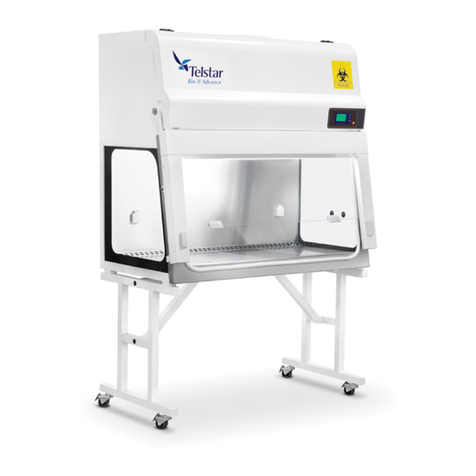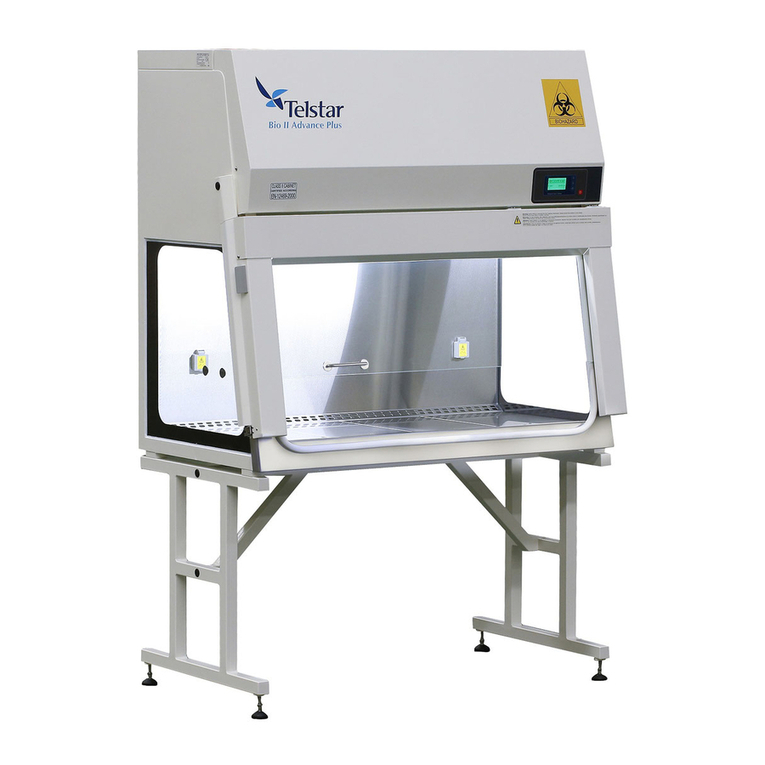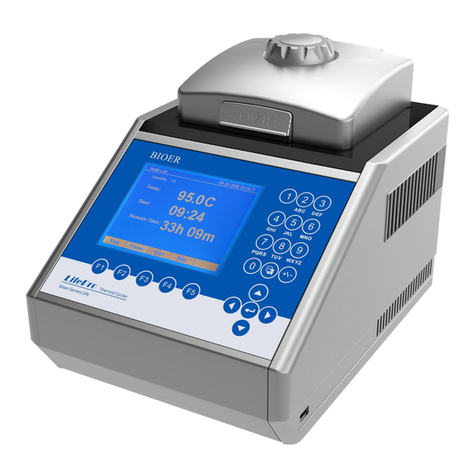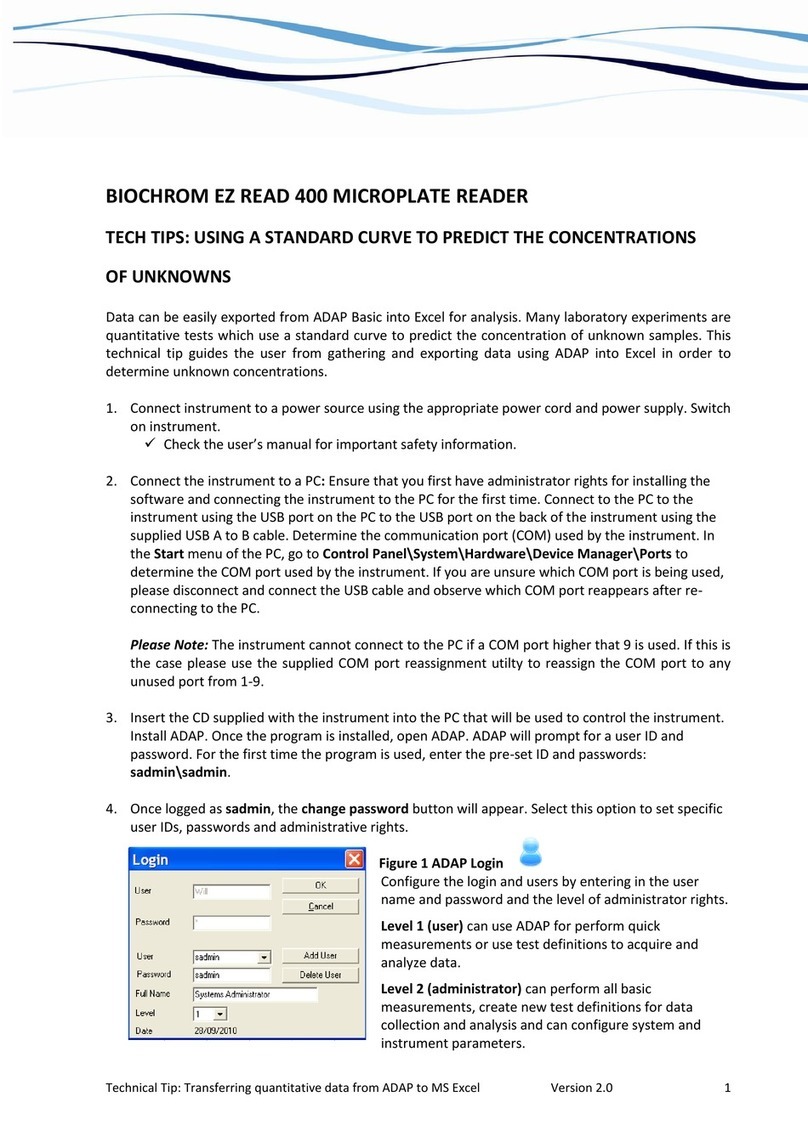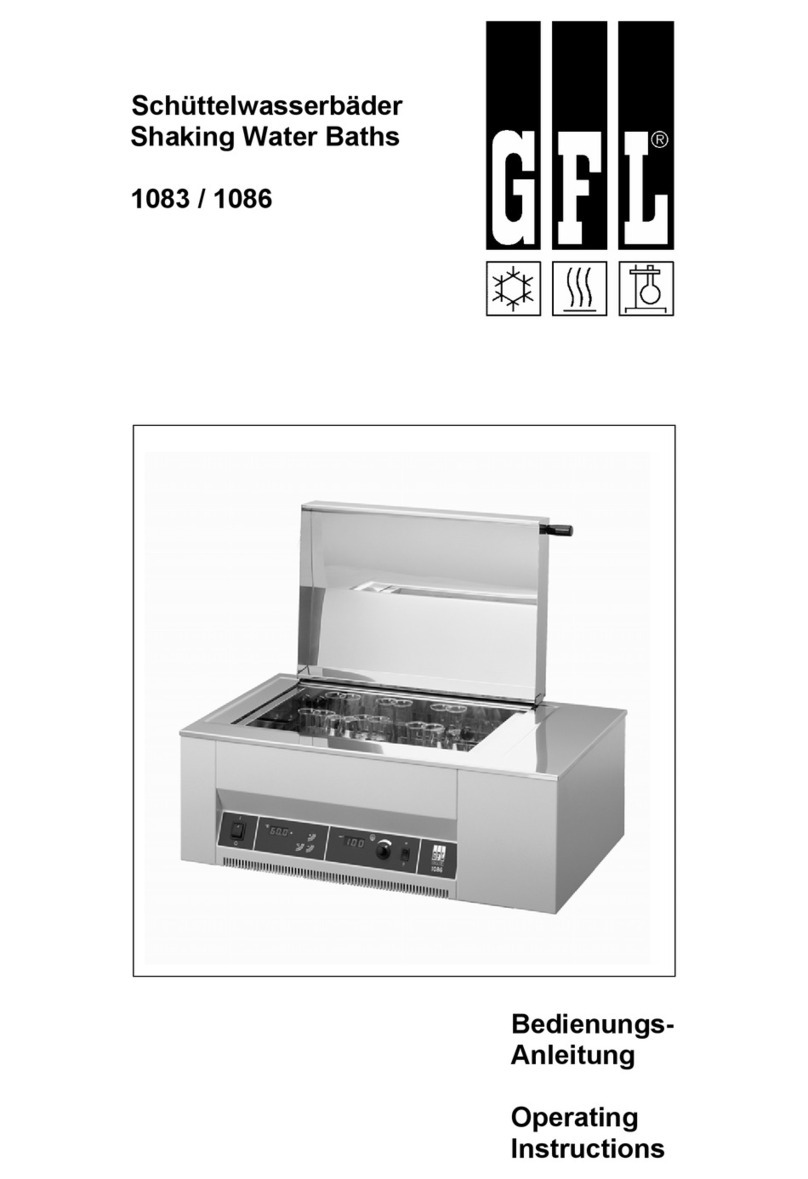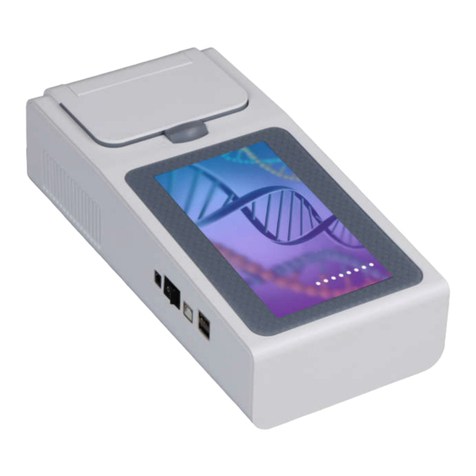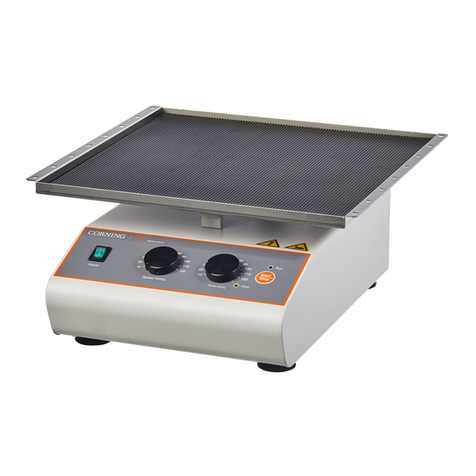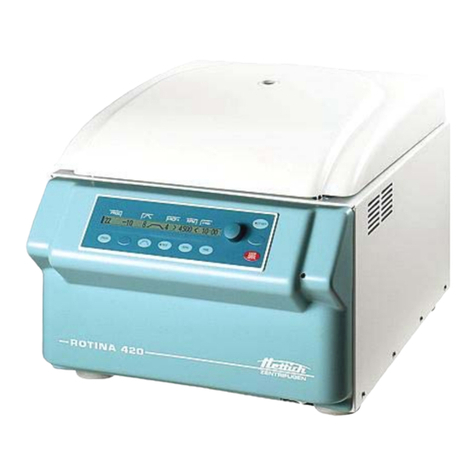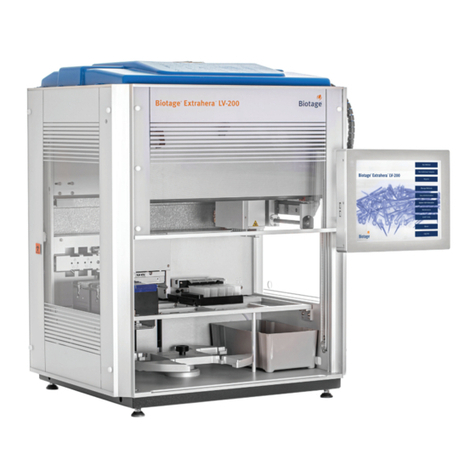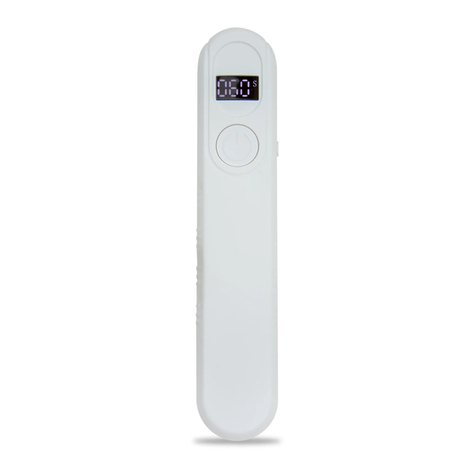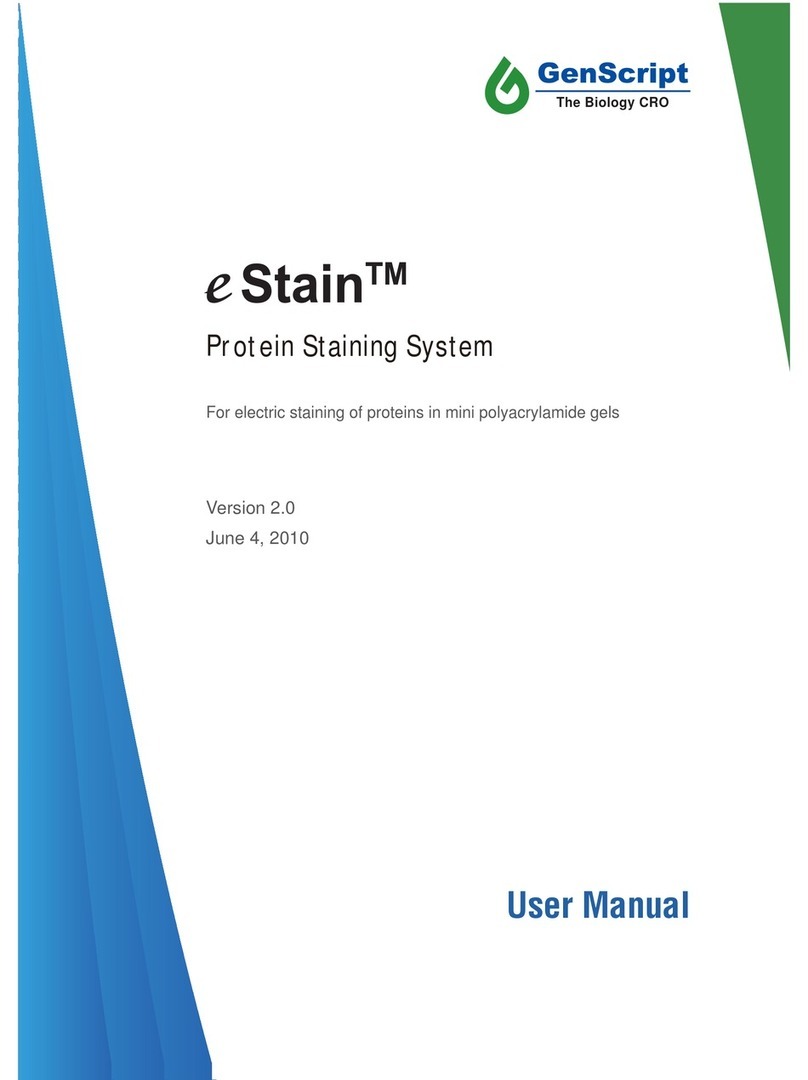Telstar Clean Air EuroFlow Series User manual

EF
EF/B
User manual
English Version 10.0
(valid for software V4.9 and higher)
Series EuroFlow,
Type EF
Biological Safety Cabinet Class II
&
Type EF/B
Biological Safety Cabinet Class II
Types:
EF 4
EF 5
EF 6
EF/B 4
EF/B 6
Offers protection for personnel,
environment and product.
Before using the safety cabinet, please read
this manual carefully. The required
instructions have to be carried out first.
Clean Air Techniek B.V.
Kuipersweg 37
3449 JA Woerden
Nederland
t: +31 (0) 348 41 11 14
f: +31 (0) 348 42 26 84
e: info@cleanair.eu
i: www.cleanair.eu

EuroFlow EF and EF/B Biological Safety Cabinet
UM-EFAB-EN10.doc
2
Preface
Congratulations with your new biological safety cabinet Class II, Series EuroFlow, type EF and/or
type EF/B. This Dutch quality product is designed, produced and tested by Clean Air Techniek B.V.,
in our production facility in Woerden, The Netherlands.
The primary function of the safety cabinet is safety for operator, product and environment. Basic
principle of the design are the latest standards regarding biological safety. Type EF meets all the
latest requirements, including the European standard EN 12469:2000 for Microbiological Safety
Cabinets. Type EF/B meets all the latest requirements, including the European standard EN
12469:2000 for Microbiological Safety Cabinets and DIN 12980:2005-06 for Safety Cabinets for
cytotoxics.
The standards EN 12469:2000 and DIN 12980:2005-06 describe only the minimum requirements.
They serve as the base for the high demands Clean Air Techniek B.V. pursuits for its products.
Type EF and type EF/B are high quality products, constructed with high grade components and
materials.
Besides providing biological safety, the wishes and demands of the operators have been important
basic principles for the design. Examples are ergonomics, design and usability.
The above-mentioned motivations have resulted in the most progressive safety cabinets currently
available, known for their superior quality, reliable performance, solid construction and many
available options, accessories, related products and the possibility to incorporate weighing
systems, microscopes etc or even build completely custom made cabinets. Furthermore, type EF
and EF/B are service friendly installations.
The safety cabinet is equipped with new techniques, such as:
•Microprocessor control with a LCD display for the interface with the operator
•Automatic up speeding fan; when the filter resistance increases, the necessary airspeeds
are maintained
•Window construction with a user-friendly hinge mechanism
We thank you for buying this cabinet and wish you good times working with the biological safety
cabinet class II type EF and/or type EF/B. For questions, advice, training, validation, service and
product adjustments please contact us.
Clean Air Techniek B.V.
Version table
Ver. 10.0 02-08-10 MPE Logo updated, preface revised
Version: Date: From serial
number:
By: Check: Change:
©Copyright 2010
All rights reserved. Nothing from this edition may be copied, or used in an automated database, or made public, either electronic,
mechanical, by photocopies, recordings, or in any manner, without preceding written permission of Clean Air Techniek B.V. This also
counts for the accompanying figures and/or plans.
Clean Air Techniek B.V. is entitled to change parts on each desired moment, without preceding or direct notification of the customer.
The content of this user manual can be changed without preceding warning as well. For information concerning maintenance activities
or repairs which are not mentioned in the user manual, please contact the service organization.
This user manual has been put together with all possible care, but Clean Air Techniek B.V. cannot take the responsibility for possible
mistakes in this user manual or for the consequences of it.

EuroFlow EF and EF/B Biological Safety Cabinet
UM-EFAB-EN10.doc
3
TOC
1Introduction_______________________________________________ 6
1.1 EF___________________________________________________________________6
1.2 EF/B _________________________________________________________________7
2Safety____________________________________________________ 8
2.1 Use in conformity with regulations _________________________________________8
2.2 Modifications and changes to the installation _________________________________8
2.3 Authorized persons _____________________________________________________8
2.4 General safety aspects __________________________________________________9
2.5 Cytotoxic danger (EF/B only) ____________________________________________10
2.6 Explanation user safety symbols __________________________________________10
3Installation ______________________________________________ 11
3.1 Assembly-instruction ___________________________________________________11
3.2 Transport instructions __________________________________________________12
3.3 Dismantling & Disposal _________________________________________________12
4Product description ________________________________________ 13
4.1 Type plate ___________________________________________________________14
4.2 Short user manual (sticker)______________________________________________14
4.3 Body of the cabinet ____________________________________________________14
4.4 Hinge-slide window ____________________________________________________15
4.5 Top hood ____________________________________________________________15
4.6 Worktop _____________________________________________________________15
4.7 Aerofoil______________________________________________________________15
4.8 Plenum-construction ___________________________________________________15
4.9 Drip tray/pre-filter (only EF/B and as an option for the EF)_____________________16
4.10 Downflow HEPA filter___________________________________________________16
4.11 Downflow protection ___________________________________________________16
4.12 Exhaust HEPA filter ____________________________________________________16
4.13 Support frame (optional)________________________________________________16
4.14 Feet support (assembled on 4.13) ________________________________________16
4.15 Front panel __________________________________________________________16
4.16 Back panel ___________________________________________________________17
4.17 Main power connection _________________________________________________17
4.18 Electronics ___________________________________________________________17
4.19 Operating panel _______________________________________________________18
4.20 FL-lighting ___________________________________________________________18
4.21 Fan_________________________________________________________________18
4.22 Optional Fittings ______________________________________________________18
4.23 Sockets______________________________________________________________21
4.24 Housing of the first HEPA filter (EF/B only) _________________________________21
4.25 First HEPA filters (EF/B only)_____________________________________________21

EuroFlow EF and EF/B Biological Safety Cabinet
UM-EFAB-EN10.doc
4
5Control__________________________________________________ 22
5.1 Using the cabinet______________________________________________________22
5.2 Top hood/sliding window _______________________________________________22
5.3 Display interface ______________________________________________________25
5.4 Starting up the cabinet _________________________________________________26
5.5 Locking functions cabinet _______________________________________________27
5.6 Power save mode _____________________________________________________28
5.7 Turn off _____________________________________________________________28
5.8 Control UV (optional)___________________________________________________29
5.9 Control gas supply (optional) ____________________________________________30
5.10 Control sockets _______________________________________________________31
5.11 Menu functions _______________________________________________________31
5.12 General Information ___________________________________________________32
5.13 Information status cabinet ______________________________________________40
5.14 Settings _____________________________________________________________42
6Alarms __________________________________________________ 47
6.1 Most frequent window alarms ____________________________________________47
6.2 Flow alarms __________________________________________________________48
6.3 Other alarms _________________________________________________________49
7Cleaning_________________________________________________ 51
7.1 Cleaning the installation ________________________________________________51
7.2 Cleaning the UV-light (optional) __________________________________________53
7.3 Guideline for cleaning of cytotoxic contaminated surfaces (EF/B only) ____________54
8Small maintenance and testing _______________________________ 56
8.1 Periodic maintenance __________________________________________________56
8.2 Replacement of the pre-filter ____________________________________________56
8.3 Replacing the Fluorescent-light (FL light) ___________________________________59
8.4 Service contact _______________________________________________________59
8.5 Service Contract_______________________________________________________60
8.6 Testing ______________________________________________________________60
9Technical specifications _____________________________________ 61
9.1 Physical surrounding ___________________________________________________61
9.2 General specifications __________________________________________________61
10 Trouble shooting __________________________________________ 65
Appendix I: Support frames EF & EF/B _____________________________ 66
Appendix II: Disinfection________________________________________ 67
Appendix III: Replacement of the HEPA filters _______________________ 68
1. When does a HEPA filter need to be replaced? ______________________________68
2. Replacement of HEPA filters _____________________________________________69
Appendix IV: Efficiency test of the HEPA filters_______________________ 74

EuroFlow EF and EF/B Biological Safety Cabinet
UM-EFAB-EN10.doc
5
Requirements ______________________________________________________________74
Appendix V: Measuring method air velocities ________________________ 76
Air velocities downflow_______________________________________________________76
Air velocities inflow*1________________________________________________________76
Appendix VI: Lay-out boards_____________________________________ 78
Appendix VII: Alarm-test procedure _______________________________ 79
Appendix VIII: Stickers _________________________________________ 81
Appendix IX: Information installed options__________________________ 84
Exhaust hood ______________________________________________________________84
Installed options microprocessor _______________________________________________84
Appendix X: User code__________________________________________ 87
Activating the user code _____________________________________________________87
Changing the user code ______________________________________________________88
Appendix XI: Required specifications ______________________________ 89
Overview of the required specifications according to EN 12469:2000 __________________89
Overview of the required specifications according to DIN 12980:2005 _________________90
Appendix XII: Part list critical components __________________________ 91
Appendix XIII: Short user manuals ________________________________ 93
Appendix XIV: TUV Low Pressure Mercury Lamps _____________________ 94
Appendix XV: Statement of the agreement for machines _______________ 95
Appendix XVI: Memo___________________________________________ 96
Index_______________________________________________________ 97

EuroFlow EF and EF/B Biological Safety Cabinet
UM-EFAB-EN10.doc
6
1Introduction
1.1
EF
The EF is a class II Biological Safety Cabinet. It gives the user the possibility to work safely and
sterile with bioagentia without complete physical barrier between person and experiment (through
work opening (C)).
•Working surface (A) is kept clear of particles by
means of a clean downflow of air.
•Because of the downflow air passed through a
HEPA filter (High Efficiency Particulate Air), the
working area of the cabinet is free of particles.
•This airflow is laminar, the airflow has got no
turbulence and has got a constant air speed.
•Through the work opening (C) air is drawn into
the workspace (inflow), towards the front slots of
the worktop. This protects the personnel against
pathogenic aerosols that might be released.
•The downflow and inflow air is then drawn
through a pre-filter (B) by a fan (E). This fan
blows the air in the correct proportion to the
downflow HEPA filter (D) and the exhaust HEPA
filter (F).
•The extracted air of the cabinet can recirculate
into the laboratory or can be blown into an
exhaust channel.
Figure 1 Sectional view EF

EuroFlow EF and EF/B Biological Safety Cabinet
UM-EFAB-EN10.doc
7
1.2
EF/B
The EF/B is a class II Biological Safety Cabinet. It gives the user the possibility to work safely and
sterile with bioagentia without complete physical barrier between person and experiment (through
work opening (C)).
•Working surface (A) is kept clear of particles by
means of a clean downflow of air.
•Because of the downflow air passed through a
HEPA filter (High Efficiency Particulate Air), the
working area of the cabinet is free of particles.
•This airflow is laminar, the airflow has got no
turbulence and has got a constant air speed.
•Through the work opening (C) air is drawn into
the workspace (inflow), towards the front slots of
the worktop. This protects the personnel against
pathogenic aerosols that might be released.
•The downflow and inflow air is then drawn
through a pre-filter (B) and a V-shaped HEPA filter
(G) by a fan (E), mounted on a plenum
construction. This fan blows the air in the correct
proportion to the downflow HEPA filter (D) and the
exhaust HEPA filter (F).
•The extracted air of the cabinet can recirculate
into the laboratory or can be blown into an
exhaust channel.
•In case the cabinet is used for cytostatics
production, the cabinet has to be connected to an
external exhaust channel.
Figure 2 Sectional view EF/B

EuroFlow EF and EF/B Biological Safety Cabinet
UM-EFAB-EN10.doc
8
2Safety
2.1
Use in conformity with regulations
Personnel that is not properly informed about the safety regulation and/or does not meet the
requirements mentioned in
§2.3 Authorized persons
, is not allowed to use the cabinet.
Improper use of the cabinet is not allowed.
2.2
Modifications and changes to the installation
In order to operate the installation safely changes and/or alterations shall only be made by Clean
Air Techniek B.V., or shall be made after consultation with and permission in writing from Clean Air
Techniek. If modifications and changes are made on own initiative, without permission from Clean
Air Techniek B.V., the parts of the installation concerned are no longer covered by the warranty.
Clean Air Techniek B.V. cannot be held liable for the consequences of the modifications and the
dangers, which might possibly occur as a result. The modifications mentioned here include the
connection of the installation to an exhaust system.
2.3
Authorized persons
Operating the installation
The cabinet shall only be used by personnel which:
•is familiar with the content, regulations and warnings which are mentioned in this operating
manual;
•is familiar with how to operate the cabinet;
•is familiar with the start up procedure, the stop procedure and Knows how to react in case of
emergency;
•is familiar with the regulations to keep the safety in all circumstances;
•is capable to end a disturbance.
Maintenance and repair general
Maintenance shall only be performed by professional service engineers, who are sufficiently trained
by Clean Air Techniek B.V. to:
•Estimate and avoid the dangers of the installation;
•Estimate the consequences of their actions.
•Before starting maintenance to the installation (mechanical and/or electric) disconnect the
power supply. Pay attention to rotating parts, after switching off the installation the fans will
still rotate for a while.
Maintenance and repair of the electrical installation
Maintenance shall only be performed by professional electro-technical service engineers, who are
sufficiently trained by Clean Air Techniek B.V. when:
•They can estimate and avoid the dangers of the installation;
•They can estimate the consequences of their actions;

EuroFlow EF and EF/B Biological Safety Cabinet
UM-EFAB-EN10.doc
9
•They are sufficiently informed about the operation of the installation and the operation of the
sub-systems.
2.4
General safety aspects
1. The installation shall never be used for any (micro-) biological or any other potentially dangerous work,
unless the fan is switched into working mode, the sliding window is in working position and there is no
alarm.
2. It is strongly advised not to slide the window out of the working position, during working with the
installation. When it is necessary to increase the work opening, this interruption needs to be as short as
possible.
3. When the installation is not used, the window shall always be closed, with the fan off, or switched onto
power-save mode, to prevent that dust particles etc. from the room can get into the installation (or worse:
material from the installation can get into the room).
4. Always try to limit the amount of equipment in the workspace. Each object in the workspace will disturb
the pattern of the airflow and a large number of equipment may lead to serious disruptions.
5. Materials such as Petri dishes or tissues should, during activities, never cover the slots of the worktop,
since no protection of the personnel can be guaranteed.
6. Do not use a centrifuge in the workspace. Even a small centrifuge is large in comparison with the work
surface and its presence may seriously disrupt the airflow. In addition, all centrifuges themselves create an
airflow, which may fling particles out of the casing.
7. When homogenizers are used in the installation, all reservoirs have to be secured by screw connections,
so that a sudden emission of fluids or aerosols will be avoided. To protect the personnel, glass reservoirs are
suitable for protection. High-speed homogenizers may cause air turbulence, as do centrifuges.
8. Even with the best technology, there may still be a risk that the hands and arms of the personnel get
contaminated during the work. Movements shall be kept to a minimum. Protective clothing shall have tightly
fitting cuffs. The use of hand gloves and over sleeves is recommended.
9. Always use a chair with the correct height. This enables the personnel to have a good view through the
sliding window. User should sit in such a position, that looking under the edge of the sliding window during
the work is not possible.
10. It is important to keep the biological safety cabinet clean. Minor contaminations are not always
immediately visible and could easily be forgotten. This increases the possibility that potentially infective
material is left behind and may cause serious contamination of the interior of the installation or worse.
Regularly clean the worktop, the bottom side, as well as the space under the worktop, in particular. In case
of doubt consider disinfection or contact Clean Air Techniek B.V. about the possibilities.
11. Transport and installation of the cabinet is only allowed for authorized staff. Please contact the
manufacturer or the seller of the products.

EuroFlow EF and EF/B Biological Safety Cabinet
UM-EFAB-EN10.doc
10
2.5
Cytotoxic danger (EF/B only)
Before starting work in cytotoxics production the hazard risks of cytotoxics handling need to be
evaluated and documented (industrial safety act, hazardous substances regulations). Based on
these findings the employees must be instructed.
2.6
Explanation user safety symbols
GENERAL DANGER
You can harm yourself and others seriously if you
do not follow the procedures carefully.
DANGER FOR ELECTROCUTION
BIOLOGICAL DANGER
DANGER OF EXPLOSION
DANGER BY INDUSTRIAL VEHICLE
CYTOTOXIC DANGER

EuroFlow EF and EF/B Biological Safety Cabinet
UM-EFAB-EN10.doc
11
3Installation
GENERAL DANGER
Be careful: high centre of gravity, crossover point.
Never hinge the window, as long as the cabinet is
not placed on the support frame
The cabinet must be installed in a safe way. Clean Air Techniek B.V. supplies an optional support
frame, which is designed for this purpose.
When the cabinet is purchased without a support frame, it is advised to discuss the installation
with the supplier.
3.1
Assembly-instruction
The cabinet has to be placed on the support frame recommended by the supplier. The assembly
needs to be done as specified in instruction underneath.
Assembly support frame
Build the support frame (see
Appendix I: Support frames EF & EF/B on page 66
for an explaining
drawing):
•Mount the support yoke (Pos. 1) to the reinforcement plate (Pos. 3);
•Mount (optional) feet support (Pos. 2).
•Item no. 6 is used to position the cabinet to the support frame (see
§3.1 Placing the cabinet on
page 11
).
Placing the cabinet
•Place the cabinet right on the forks of a forklift truck or lifting platform;
DANGER BY INDUSTRIAL VEHICLE
Be careful: Make sure the cabinet cannot slide from
the forks.
•Move the cabinet to the correct height and position, perform this action as precise as possible
above the support frame;
•The weight must be equally divided between the both forks and the cabinet must be horizontal
levelled;
•The cabinet should be aligned with the covers of the support frame.
The two cones on top of the yokes will help aligning;
•Mount the cabinet to the support frame by means of the four inner hexagonal cylinder screws
M8x12 (Pos. 6). See
Appendix I: Support frames EF & EF/B on page 66
;
•Connect the wire to a grounded socket that is easy accessible.

EuroFlow EF and EF/B Biological Safety Cabinet
UM-EFAB-EN10.doc
12
In case of maintenance the cabinet must be completely free of voltage. This means that the
connector in the socket must be easy to reach, otherwise a main-switch must be mounted
between the cabinet and the power supply so that the cabinet can be cut off of the power-circuit.
3.2
Transport instructions
Before moving the cabinet make sure the power cable is disconnected of the power supply
The cabinet must be transported on a strong solid pallet.
After every transport the cabinet must be tested and calibrated.
GENERAL DANGER
Be careful: High center of gravity, crossover point.
3.3
Dismantling & Disposal
For dismantling and disposal follow the next instructions:
•See
§7.1 Cleaning the installation on page 51;
•See
§8.2 Replacement of the pre-filter on page 56
;
•See
Appendix II: Disinfection on page 67;
•See
Appendix III: Replacement of the HEPA filters on page 68;
•Break the unit down into its component parts. You can re-cycle these components parts,
dispose them in accordance with local requirements.
For advice or information about dismantling or disposal please contact Clean Air Techniek B.V.

EuroFlow EF and EF/B Biological Safety Cabinet
UM-EFAB-EN10.doc
13
4Product description
Figure 3 Sectional view EF
Figure 4 3D view EF
Figure 5 Sectional view EF/B Figure 6 3D view EF/B

EuroFlow EF and EF/B Biological Safety Cabinet
UM-EFAB-EN10.doc
14
Part list EF and EF/B
1 Type plate
2 Short user manual
3 Body of the cabinet
4 Hinge/slide window
5 Top hood
6Worktop
7Aerofoil
8Plenum-construction
9Drip tray/pre-filter
10 Downflow filter
11 Downflow protection (build in)
12 Exhaust filter
13 Support frame (optional)
14 Feet support
15 Front panel
16 Back panel
17 Mains connection
18 Electronics
19 Operating panel
20 Lightning
21 Fan
22 Optional fittings
23 Sockets
EF/B only:
24 Housing of first HEPA filter
25 First HEPA filter
4.1
Type plate
The type plate (
Figure 3, Figure 4, Figure 5
and
Figure 6,
Pos. 1) mentions instructions that are
important for the connection of the biological safety cabinet. See
Appendix VIII: Stickers on page
81
.
4.2
Short user manual (sticker)
The short user manual (
Figure 3, Figure 4, Figure 5
and
Figure 6,
Pos. 2) gives a brief overview of
the primary functions, and is included with the cabinet. See also
Appendix XIII: Short user manual
on page 93
.
4.3
Body of the cabinet
The body of the installation (
Figure 3, Figure 4, Figure 5
and
Figure 6,
Pos. 3) is made of epoxy-
coated steel. The interior of the body is made of stainless steel (304). The body is leak tight as per
LI-C (table 1 and 4 of the EN 12469:2000-standard). The body has been tested according to the
method described in annex 2 of the EN 12469:2000.

EuroFlow EF and EF/B Biological Safety Cabinet
UM-EFAB-EN10.doc
15
4.4
Hinge-slide window
The hinge-slide window (
Figure 3, Figure 4, Figure 5
and
Figure 6,
Pos. 4) is a tightly closing,
manually operated glass window. It can be slid up or down, and opened and closed by means of
handgrips. The window construction contains two guiding profiles with a compression spring. The
spring will push a ball into a hole in the guiding shaft when the window enters the working
position (this working position is also indicated by means of two blue indication stickers).
The window can be hinged, but only in the hinge position, the top hood has to be opened first.
See
§5.2 Top hood/sliding window on page 23
. The hinge option offers the advantage that even
larger objects can be placed inside the working space. It also makes cleaning the working space as
well as the inside of the window easier(see
7.1 Cleaning the installation
on page 51
).
4.5
Top hood
In and behind the top hood (
Figure 3, Figure 4, Figure 5
and
Figure 6,
Pos. 5) a number of
electrical components are assembled.
•FL lighting
•Operating panel / operating board
•Interface board, including engine control
•Additional option print.
If you wish to check one of these components, you need to hinge the top hood.
To check the interface board, the safety-cover has to be taken away (authorized service personnel
only). Caution! Some of the components are live and therefore carry a risk of electrical shock as
long as the mains plug is connected.
4.6
Worktop
The workroom contains a stainless steel (type 304) worktop (
Figure 3, Figure 4, Figure 5
and
Figure 6,
Pos. 6) with a deepened work surface. This deepened work surface is called the safe
working area (for information about the dimensions see
§9.2 General specifications on page 61)
.
At the front and the back there are air slits, which are essential to the functioning of the
installation. At the two sides two panels have been placed (See detail Pos. 6)
4.7
Aerofoil
The aerofoil (
Figure 3, Figure 4, Figure 5
and
Figure 6,
Pos. 7) is used for a better air conduction
and to support the elbow. During work with the cabinet the aerofoil needs to be installed. The
aerofoil is made of coated aluminium for better ergonomics. (less weight and less heat
transportation)
4.8
Plenum-construction
The plenum-construction (
Figure 3, Figure 4, Figure 5
and
Figure 6,
Pos. 8) divides the air, which
is let in by the fan, between the downflow HEPA filter and the exhaust HEPA filter.

EuroFlow EF and EF/B Biological Safety Cabinet
UM-EFAB-EN10.doc
16
4.9
Drip tray/pre-filter (only EF/B and as an option for the EF)
The pre-filter with drip tray (EF:
Figure 3
and
EF/B:
Figure 5,
Pos. 9) is assembled under the
worktop. The installation is equipped with this to protect the interior of the installation against
pollution by coarse materials and to collect spilled fluids. Furthermore the pre-filter will enhance
the life span of the HEPA filter significantly.
4.10
Downflow HEPA filter
The downflow HEPA filter (
Figure 3, Figure 4, Figure 5
and
Figure 6,
Pos. 10) has a very high
efficiency: Class H14 in accordance with EN1822. After assembling, each filter will be tested
separately according to EN12469:2000, Annex D. Through the service panel the downflow filter
can be reached (Pos. 15).
4.11
Downflow protection
The downflow filter has a build-in protection grid (
Figure 3, Figure 4, Figure 5
and
Figure 6,
Pos.
11).
4.12
Exhaust HEPA filter
The exhaust HEPA filter (
Figure 3, Figure 4, Figure 5
and
Figure 6,
Pos. 12) has a very high
efficiency: Class H14 in accordance with EN1822. After assembling, each filter will be tested
separately according to EN 12469:2000, Annex D. Through the topside of the cabinet the exhaust
filter can be reached.
4.13
Support frame (optional)
For a stable positioning of the cabinet, we strongly recommend the use of the especially designed
support frame from the supplier (
Figure 3, Figure 4, Figure 5
and
Figure 6,
Pos. 13).
This support frame includes an in steps adjustable feet support for a good ergonomic work
position (
Figure
3
, Figure 4, Figure 5
and
Figure 6,
Pos. 14). As well, the feet support will increase
the stability of the cabinet. In addition, it is recommended to use an in height adjustable, well
disinfectable chair to optimize the work position.
4.14
Feet support (assembled on 4.13)
The support frame includes an in steps adjustable feet support for a good ergonomic work position
(
Figure 3, Figure 4, Figure 5
and
Figure 6,
Pos. 14). As well, the feet support will increase the
stability of the cabinet. In addition, it is recommended to use an in height adjustable, well
disinfectable chair to optimize the work position.
4.15
Front panel
The service panel (
Figure 3, Figure 4, Figure 5
and
Figure 6,
Pos. 15) can be dismantled to get
access to:
•the downflow filter;

EuroFlow EF and EF/B Biological Safety Cabinet
UM-EFAB-EN10.doc
17
•the fan.
GENERAL DANGER / BIOLOGICAL DANGER
Cabinet must be disinfected before removing the
front panel
4.16
Back panel
The back panel (
Figure 3, Figure 4, Figure 5
and
Figure 6,
Pos. 16) can be dismantled to get
access to:
•optional fittings;
•sockets.
GENERAL DANGER / BIOLOGICAL DANGER
Cabinet must be disinfected before removing the
back panel
4.17
Main power connection
The main power connection (Figure 3, Figure 4, Figure 5
and
Figure 6,
Pos. 17) is positioned on
the top of the cabinet. The cord length is maximum 3 meters and should always be accessible. See
§9.2 General specifications on page 61
for details
.
4.18
Electronics
The electronics (
Figure 3, Figure 4, Figure 5
and
Figure 6,
Pos. 18) consist of:
•Operational print; positioned in the top hood behind the operating panel;
•Control print, positioned under the top hood, behind the safety-cover, including:
oFuse holders (see
§9.2 General specifications on page 61
for fuse-numbers).
oFan control. The control is free adjustable in the range between 0% and 100%
oAn Air velocity compensating microprocessor regulates the fan speed to compensate
for main power fluctuations and filter pollution.
oIndependent potential free output contact (interface board connector J6).
See
Interface board on page 78.
oMain filter
oLight ballast + starter for UV (Option)
oLight ballast for FL-light
oOption board (see
Appendix
VI: Lay-out boards
on page 78
)

EuroFlow EF and EF/B Biological Safety Cabinet
UM-EFAB-EN10.doc
18
4.19
Operating panel
Figure 7 Operating panel
The operating panel (
Figure 3, Figure 4, Figure 5
and
Figure 6,
Pos. 19 and
Figure 7
) consists of:
1. Display;
2. Function keys (4x);
3. Fixed keys (4x);
4. Signals.
4.20
FL-lighting
The Fluorescent-lighting (
Figure 3, Figure 4, Figure 5
and
Figure 6,
Pos. 20) is assembled behind
the top hood.
4.21
Fan
The fans with the motor (
Figure 3, Figure 4, Figure 5
and
Figure 6,
Pos. 21) are maintenance-free,
double suction fans. The “Air Velocity Compensating Microprocessor” controls the fan power for
any disrupting factors such as voltage drops or filter pollution. With an installation with a double
exhaust HEPA filter, an additional fan is built in. The fan regulations are mounted behind the light
hood.
4.22
Optional Fittings
(
Figure 3, Figure 4, Figure 5
and
Figure 6,
Pos. 22)
Gas connection
This connection is assembled together with a gas valve. Normally, both the inlet and outlet gas
connections are hose connections, suitable for hoses with an inner diameter of 10 mm. All
connections on the gas supply have to be done with a certified gas hose.
After the connection on the gas supply, the gas connections have to be tested on leakage by a
certified installer.
An electrical gas valve has to be assembled on the gas connection (see Annex A.9 of the EN
12469:2000 standard) as an extra safety precaution. A coupling via the electrical system of the

EuroFlow EF and EF/B Biological Safety Cabinet
UM-EFAB-EN10.doc
19
installation makes sure that the valve can only be operated in work mode and will be switched off
automatically by leaving this mode.
The gas valve switch-function is only visible when the fan in work mode is and there are no
air speeds alarms.
Positions of the supply connection EF
•The connection, that is located inside the installation, is standard assembled on the back part
inside the work space of the biological safety cabinet.
•The connection, that is located outside the installation, is standard assembled in the bottom of
the installation.
•The connection, that is located outside the installation, can be assembled by customer request
in left or right side panel or top of the installation.
Positions of the supply connection EF/B
•The connection, that is located inside the installation, is standard assembled on the back part
inside the work space of the biological safety cabinet.
•The connection, that is located outside the installation, is standard assembled in the left or
right side panel of the installation.
•The connection, that is located outside the installation, can be assembled by customer request
in top of the installation. For EF/B-series assembly of this connection on the bottom is not
possible.
Bunsen burner lead-through set
The Bunsen burner can be plugged into the outlet with a short cable inside the work space. The
plug of the foot pedal can be inserted into an outlet. The Bunsen burner can only operate when
the cabinet is in safe work mode and button (Gas) is activated. Recommended to apply is
the Fuego Bunsen burner, available at Clean Air Techniek B.V.
Positions of the supply connection EF
•The connection, that is located inside the installation, is standard assembled in the back panel
of the workspace.
•The connection, that is located outside the installation, is standard assembled in the bottom of
the installation.
•The connection, that is located outside the installation, can be assembled by customer request
in left or right side panel or top of the installation.
Positions of the supply connection EF/B
•The connection, that is located inside the installation, is standard assembled in the back panel
of the workspace.
•The connection, that is located outside the installation, is standard assembled in the left or
right side panel of the installation.
•The connection, that is located outside the installation, can be assembled by customer request
in top of the installation. For EF/B-series assembly of this connection on the bottom is not
possible.
Vacuum connection
This connection is always assembled in combination with a vacuum tap.
Positions of the supply connection EF
•The connection, that is located inside the installation, is standard assembled in combination
with a vacuum tap in the back panel of the workspace.

EuroFlow EF and EF/B Biological Safety Cabinet
UM-EFAB-EN10.doc
20
•The connection, that is located outside the installation, is standard assembled in the bottom of
the installation.
•The connection, that is located outside the installation, can be assembled by customer request
in left or right side panel or top of the installation.
Positions of the supply connection EF/B
•The connection, that is located inside the installation, is standard assembled in combination
with a vacuum tap in the back panel of the workspace.
•The connection, that is located outside the installation, is standard assembled in the left or
right side panel of the installation.
•The connection, that is located outside the installation, can be assembled by customer request
in top of the installation. For EF/B-series assembly of this connection on the bottom is not
possible.
UV light
The UV light is meant for disinfection of the working surface of the safety cabinet.
When the UV light switches on, the FL lighting switches off. The UV light can only be switched on
when the window is closed (window on aerofoil) or when the cabinet is in disinfection mode
(aerofoil lifted up and window at its lowest point), this makes sure the user will not get in contact
with UV-C radiation.
The UV switch-function is only visible when the window is closed.
DANGER FOR BURNING
Avoid direct contact with UV-C radiation. This causes
burns to the skin and eyes.
The UV light can be switched on and off on the display (see
§5.8 Control UV (optional) on page
29
). It is also possible to adjust the UV disinfection, for each day a certain disinfection period can
be defined (see
§5.11 Set up 7 days clock UV on page 31)
.
Watch Out!
Do not touch the UV-lamp with the hand and keep the
lamp fat free; otherwise the lifetime will decrease. The
UV-light must be cleaned with alcohol (70%) regularly
(switch off the installation). See
§7.2 Cleaning the UV-
light (optional) on page 53.
This manual suits for next models
5
Table of contents
Other Telstar Laboratory Equipment manuals
Popular Laboratory Equipment manuals by other brands
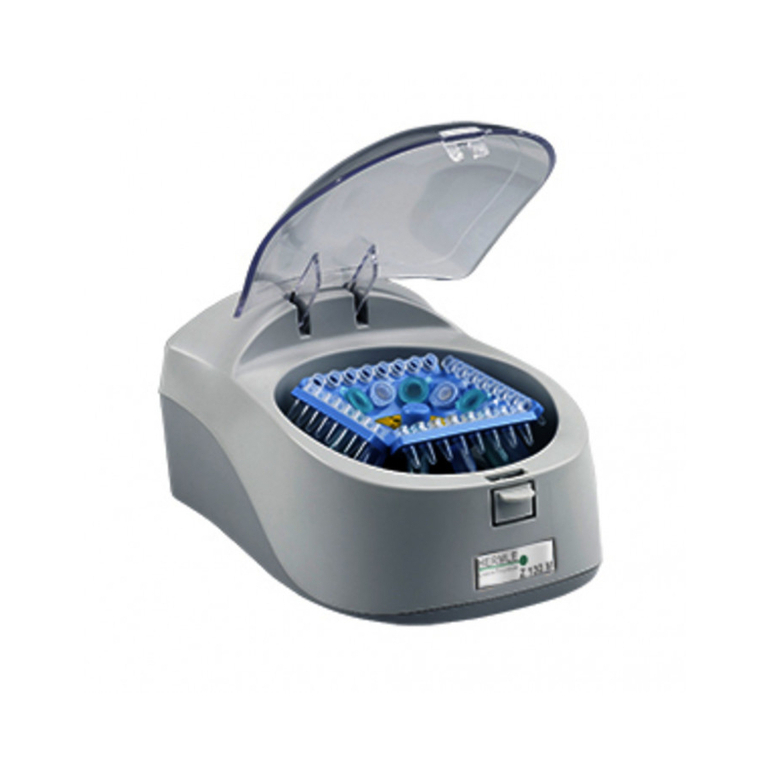
Hermle
Hermle Z 130 M operating manual

Cole Parmer
Cole Parmer HO-200 Series user manual
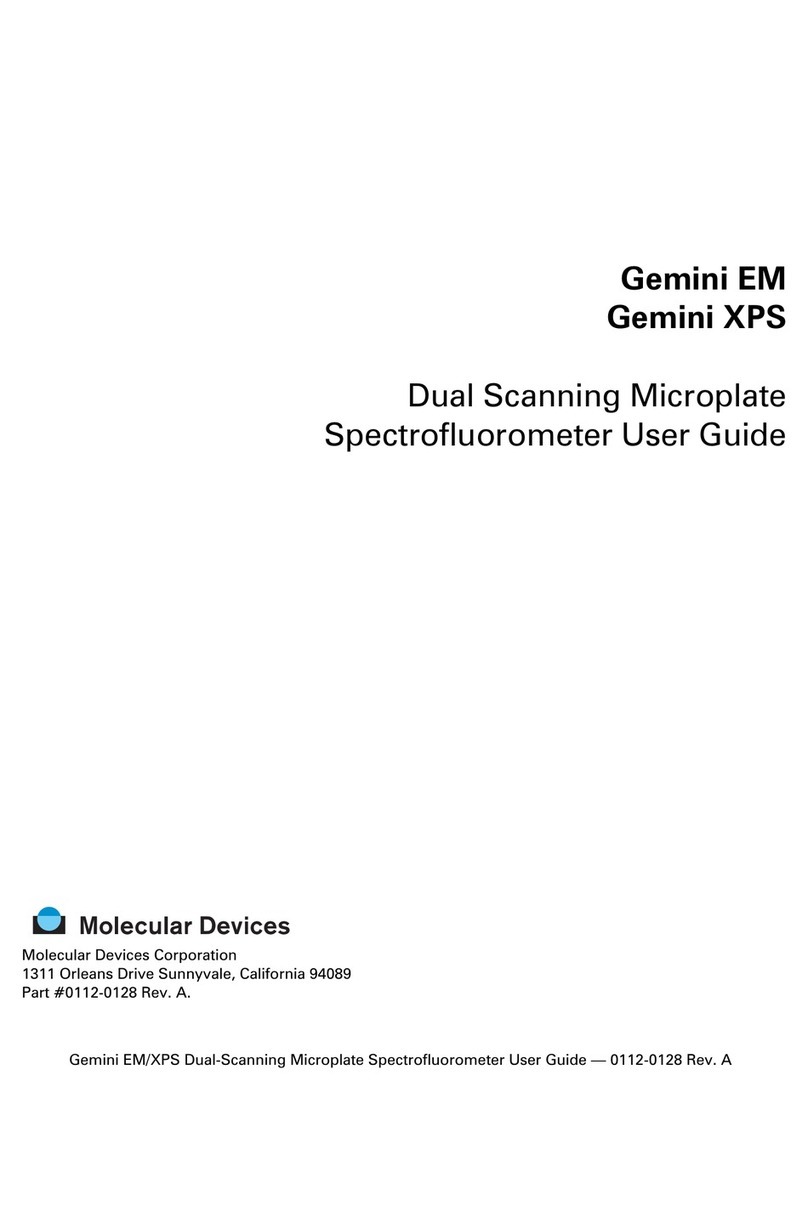
Marshall Amplification
Marshall Amplification Gemini EM user guide
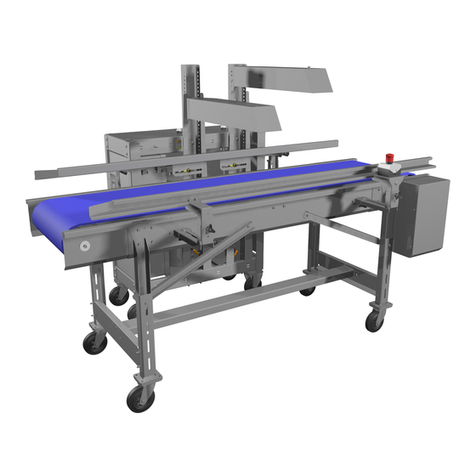
Intervet
Intervet Spraycox II Operation
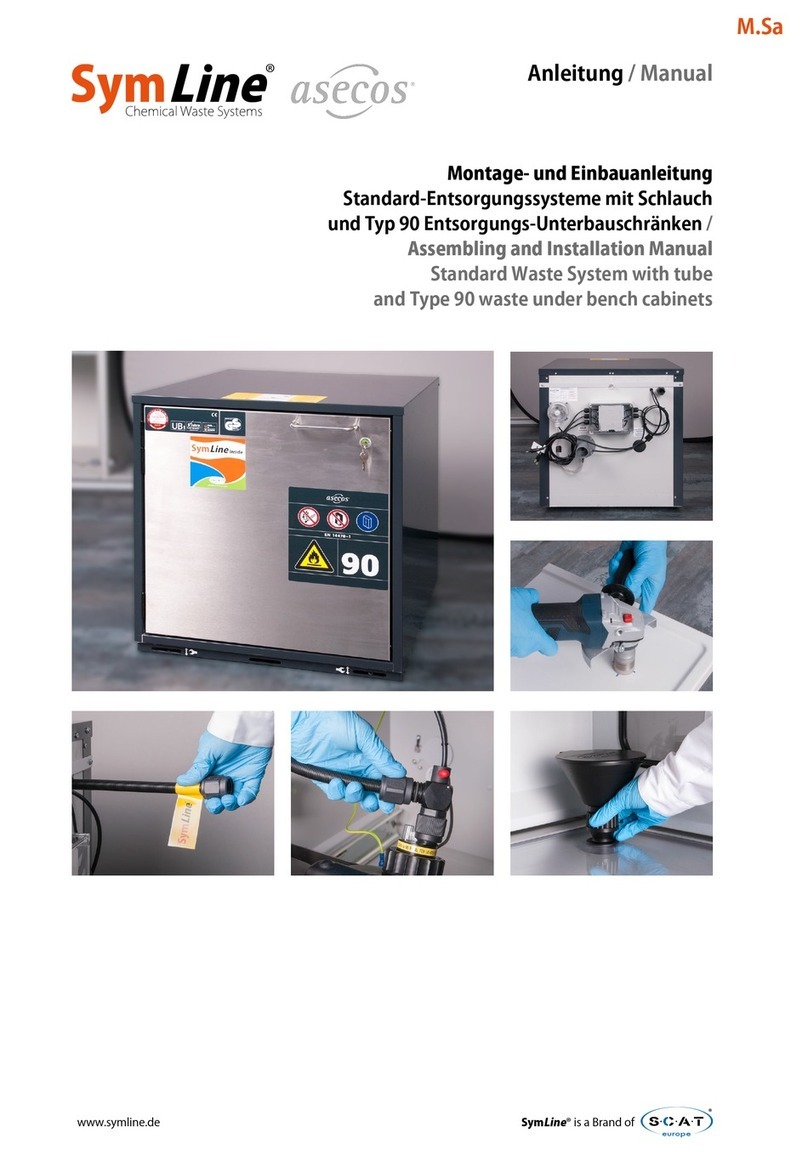
S.C.A.T. Europe
S.C.A.T. Europe SymLine asecos Assembling and installation manual
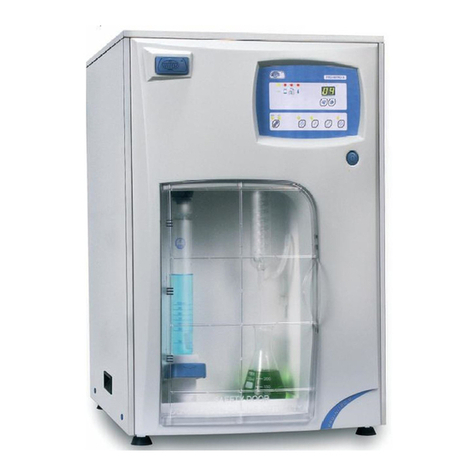
Selecta
Selecta PRO-NITRO S manual

